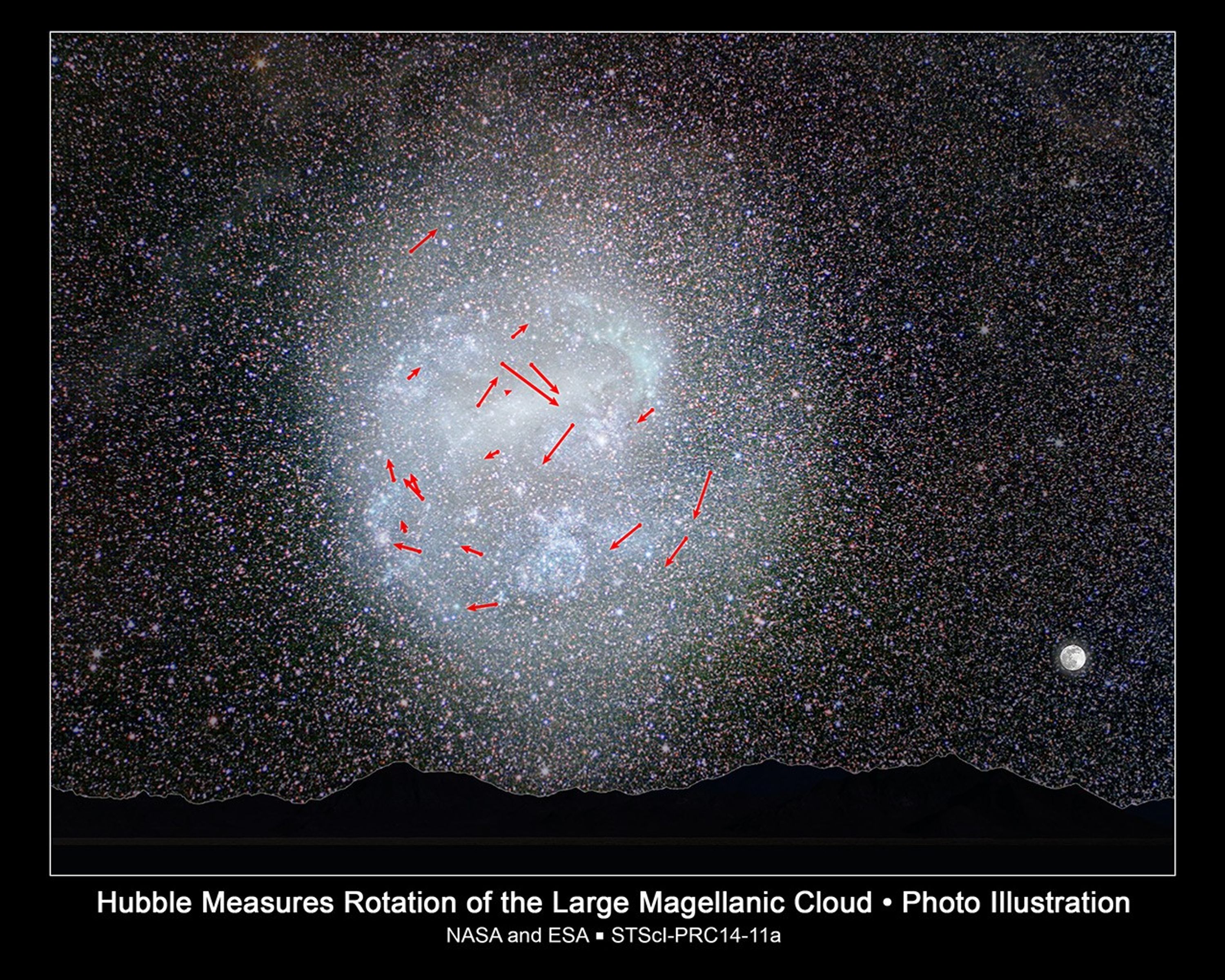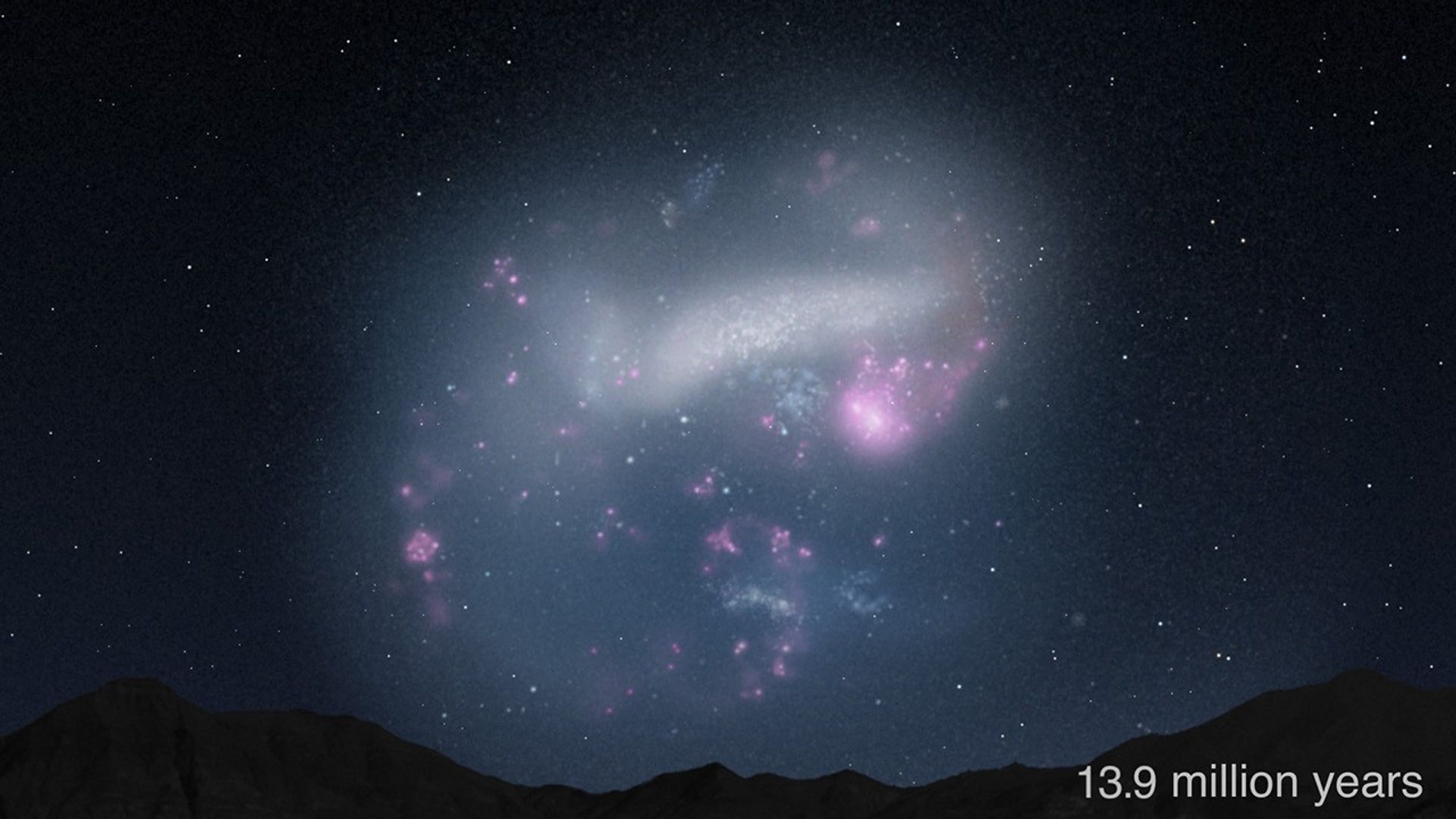1 min read
Stars’ Clockwork Motion Captured in Nearby Galaxy

This photo illustration shows Hubble measurements of the rotation of the Large Magellanic Cloud (LMC), the nearest visible galaxy to our Milky Way. The LMC appears in the Southern Hemisphere's night sky. In this photo illustration, the image contrast in a ground-based photo was enhanced to highlight the LMC's faint outer regions, which are not visible to the naked eye. To illustrate the LMC's large apparent size on the sky, an image of the full moon is shown at bottom right. A horizon has been added for perspective.
The arrows represent the highest-quality Hubble measurements of the motion of the LMC's stars to show how this galaxy rotates. Each arrow reveals the predicted motion over the next 7 million years. The motion of each star measured by Hubble over a few years' time is a million times smaller than the length of each arrow. The LMC completes a rotation every 250 million years.
About the Object
- R.A. PositionR.A. PositionRight ascension – analogous to longitude – is one component of an object's position.05h 23m 34s.53
- Dec. PositionDec. PositionDeclination – analogous to latitude – is one component of an object's position.-69° 45' 22".07
- ConstellationConstellationOne of 88 recognized regions of the celestial sphere in which the object appears.Dorado
- DistanceDistanceThe physical distance from Earth to the astronomical object. Distances within our solar system are usually measured in Astronomical Units (AU). Distances between stars are usually measured in light-years. Interstellar distances can also be measured in parsecs.170,000 light-years (52,000 parsecs)
About the Data
- Data DescriptionData DescriptionProposal: A description of the observations, their scientific justification, and the links to the data available in the science archive.
Science Team: The astronomers who planned the observations and analyzed the data. "PI" refers to the Principal Investigator.The Hubble data are from proposals 9462: C. Alcock (Harvard University), R. van der Marel (STScI), C. Nelson (University of California, Berkeley), T. Axelrod (University of Arizona), K. Cook (Eureka Scientific Inc.), A. Drake (Caltech), and M. Geha (Yale University); 10130: C. Alcock (Harvard University), N. Kallivayalil (University of Virginia), R. van der Marel (STScI), M. Geha (Yale University), K. Cook (Eureka Scientific Inc.), A. Drake (Caltech), and T. Axelrod (University of Arizona); and 11730: N. Kallivayalil (University of Virginia), R. van der Marel and J. Anderson (STScI), G. Besla (Columbia University), and C. Alcock (Harvard University). - InstrumentInstrumentThe science instrument used to produce the data.HST>WFC3/UVIS and HST>ACS/HRC
- Exposure DatesExposure DatesThe date(s) that the telescope made its observations and the total exposure time.2002 - 2010
- FiltersFiltersThe camera filters that were used in the science observations.F606W (V) and F814W (I)
- Object NameObject NameA name or catalog number that astronomers use to identify an astronomical object.Large Magellanic Cloud
- Object DescriptionObject DescriptionThe type of astronomical object.Irregular Galaxy
- Release DateFebruary 18, 2014
- Science ReleaseHubble Watches Stars’ Clockwork Motion in Nearby Galaxy
- Credit
Related Images & Videos

The Rotation Rate of the Large Magellanic Cloud
This animation illustrates the rotation rate of the Large Magellanic Cloud (LMC). Hubble Space Telescope observations have determined that the central part of the LMC completes a rotation every 250 million years. Hence, it takes more than 10 million years for even the small...
Share
Details
Claire Andreoli
NASA’s Goddard Space Flight Center
Greenbelt, Maryland
claire.andreoli@nasa.gov































